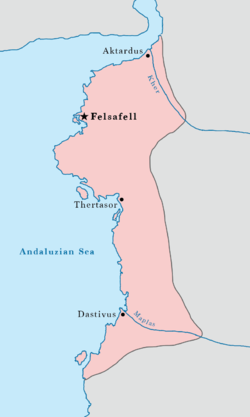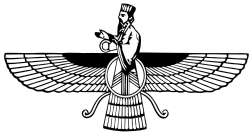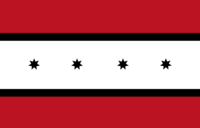Difference between revisions of "Kingdom of Vaktria"
Terranihil (talk | contribs) |
Terranihil (talk | contribs) m (Text replacement - "Ultav" to "Ultvar") |
||
| (One intermediate revision by the same user not shown) | |||
| Line 149: | Line 149: | ||
== History == | == History == | ||
=== Origins === | === Origins === | ||
| − | Proto-Vaktrian city-states existed along the Maplas and Kher rivers and the Andaluzian coast for more than a millennia before the Kingdom of Vaktria. They were generally all patriarchal autocracies ruled by a single family. The Chernastid dynasty ruled over the city-state of Dastivus (Vaktrian: ''Ḍaštivaıs''; Ϯⲁϣⲧⳅⲯⲁⲓⲋ) since c. 900 BCE. Chernastum I, whom his dynasty is named for, began a military campaign in 875 BCE to conquer neighboring cities. By the beginning of the 8th century BCE, he had conquered all of the Vaktrian speaking cities along the Maplas and southward. Chernastum declared himself | + | Proto-Vaktrian city-states existed along the Maplas and Kher rivers and the Andaluzian coast for more than a millennia before the Kingdom of Vaktria. They were generally all patriarchal autocracies ruled by a single family. The Chernastid dynasty ruled over the city-state of Dastivus (Vaktrian: ''Ḍaštivaıs''; Ϯⲁϣⲧⳅⲯⲁⲓⲋ) since c. 900 BCE. Chernastum I, whom his dynasty is named for, began a military campaign in 875 BCE to conquer neighboring cities. By the beginning of the 8th century BCE, he had conquered all of the Vaktrian speaking cities along the Maplas and southward. Chernastum declared himself Ultvar or king of Vaktria with Dastivus as the capital. The previous rulers of the conquered cities generally remained in power as Ultvarnin (meaning ''little ruler''). |
=== Chernastid dynasty === | === Chernastid dynasty === | ||
| − | Chernastum I died a few years after<!--795--> the establishment of the kingdom. His descendants ruled for about 200 years until 600 BCE. The rule of Chernastum's great-grandson, Miskarnam I<!--warrior-->, saw a great amount of growth within the dynasty by 705. The Chernastid rulers following his death were unable to make significant land gains, but they did significant domestic work, including introducing a reformed tax and troop levy system and building roads throughout the kingdom. The last few Chernastid | + | Chernastum I died a few years after<!--795--> the establishment of the kingdom. His descendants ruled for about 200 years until 600 BCE. The rule of Chernastum's great-grandson, Miskarnam I<!--warrior-->, saw a great amount of growth within the dynasty by 705. The Chernastid rulers following his death were unable to make significant land gains, but they did significant domestic work, including introducing a reformed tax and troop levy system and building roads throughout the kingdom. The last few Chernastid Ultvars were particularly weak, consisting of unstable and short reigns. Much of the instability was due to a drought that hurt crop growth in the land between the Maplas and Kher rivers. Putrasam I, a member of a wealthy Dastivian family, rallied support from the army and other southern nobles to take the throne c. 600. Ultvar Chernastum V, thirteen years old at the time, stepped down. |
=== Putrasamid dynasty === | === Putrasamid dynasty === | ||
| Line 182: | Line 182: | ||
=== Government === | === Government === | ||
| − | The Kingdom of Vaktria was a monarchy ruled by an | + | The Kingdom of Vaktria was a monarchy ruled by an Ultvar or king with primogeniture succession laws. Every major city and its surrounding area, aside from the capital, was ruled by an Ultvarnin. Ultvarnin could set their own laws and manage trade and taxes as long as it did not conflict with the rule of the Ultvar. Centralization varied from ruler to ruler, but generally Ultvar's allowed Ultvarnin to govern freely as long as they paid taxes, sent sufficient soldiers during wartime, and maintained peace among the nobles, peasants, and slaves. |
=== Classes === | === Classes === | ||
Revision as of 20:24, 28 June 2022
Kingdom of Vaktria Ⲯⲁⲕⲧⲣⲓⲁ Vaktrıa | |||||||||
|---|---|---|---|---|---|---|---|---|---|
|
Standard of the Havusmanid dynasty | |||||||||
 Map of Vaktria at its height in 20 BCE | |||||||||
| Capital | Dastivus (800-140 BCE Thertasor (140-50 BCE Felsafell (50 BCE-130 CE | ||||||||
| Common languages | Classical Vaktrian | ||||||||
| Religion | Astrianism | ||||||||
| Government | Monarchy | ||||||||
| Historical era | Ancient Andaluzian Coast | ||||||||
• Established | 800 BCE | ||||||||
• Putrasamid dynasty supersedes Chernastid dynasty | 600 BCE | ||||||||
• Havusmanid dynasty supersedes Putrasamid dynasty | 225 BCE | ||||||||
• Conquered by Romanyan Vaktria | 130 CE | ||||||||
• Reestablished as Septarban Kingdom | 325 CE | ||||||||
| |||||||||
The Kingdom of Vaktria, often referred to as Ancient Vaktria, Classical Vaktria, or simply Vaktria (Vaktrian: Ⲯⲁⲕⲧⲣⲓⲁ, Vaktrıa), was a monarchy on the Andaluzian coast that existed from 800 BCE to 130 CE. Its inhabitants were the ancient Vaktrians who spoke Classical Vaktrian. The kingdom was ruled successively by three dynasties: the Chernastid, Putrasamid, and Havusmanid. Its capital was Dastivus. The Romanyan Empire conquered and annexed Vaktria as a province in 130 CE.
Contents
Etymology
The native name for Vaktria is Vaktrıa from Proto-Vaktrian for road or way.
History
Origins
Proto-Vaktrian city-states existed along the Maplas and Kher rivers and the Andaluzian coast for more than a millennia before the Kingdom of Vaktria. They were generally all patriarchal autocracies ruled by a single family. The Chernastid dynasty ruled over the city-state of Dastivus (Vaktrian: Ḍaštivaıs; Ϯⲁϣⲧⳅⲯⲁⲓⲋ) since c. 900 BCE. Chernastum I, whom his dynasty is named for, began a military campaign in 875 BCE to conquer neighboring cities. By the beginning of the 8th century BCE, he had conquered all of the Vaktrian speaking cities along the Maplas and southward. Chernastum declared himself Ultvar or king of Vaktria with Dastivus as the capital. The previous rulers of the conquered cities generally remained in power as Ultvarnin (meaning little ruler).
Chernastid dynasty
Chernastum I died a few years after the establishment of the kingdom. His descendants ruled for about 200 years until 600 BCE. The rule of Chernastum's great-grandson, Miskarnam I, saw a great amount of growth within the dynasty by 705. The Chernastid rulers following his death were unable to make significant land gains, but they did significant domestic work, including introducing a reformed tax and troop levy system and building roads throughout the kingdom. The last few Chernastid Ultvars were particularly weak, consisting of unstable and short reigns. Much of the instability was due to a drought that hurt crop growth in the land between the Maplas and Kher rivers. Putrasam I, a member of a wealthy Dastivian family, rallied support from the army and other southern nobles to take the throne c. 600. Ultvar Chernastum V, thirteen years old at the time, stepped down.
Putrasamid dynasty
Putrasam I and his direct successors focused on internal affairs, which including reforming the laws and courts system. They also attempted to stimulate trade and recover from the drought. However, Rasvark II returned the Vaktrian Kingdom's focus to conquest. He began to capture northern territory in 450 and by the end of his rule in 425, he had captured Chatazifria island and neighboring lands. Rasvark II was held off from conquering any further by the city-state of Thertasor which had strong land defenses.
Following the death of Rasvark's son, Putrasam III, who had no apparent heir, an internal conflict erupted between two of Putrasam's cousins. The war waged from 410 to 390, with the younger cousin, Pirsem I, winning. The war had strained the capital's resources had caused discontent among its people. Peasant revolts began in southern Vaktria and quickly spread north. Pirsem I, his son, and his grandson spent their reigns suppressing these revolts and trying to maintain unity. His grandson, Pirsem II, was unable to prevent several northern city-states from seceding around 300. The kingdom was now two-thirds its size than under Rasvark II.
Havusmanid dynasty
The Kingdom of Vaktria was seemingly falling apart under Putrasamid rule. In 225, Havusmanor I, the patriarch of a ship-building family, led a revolt against Rasvark III in which Dastivus was captured and the Ultvar killed. Havusmanor managed to quell the internal conflict and regain some of the lost territory. Derva the Great, son of Havusmanor I, reconquered all of the lost lands by 175 BCE. He also managed the construction of a massive navy. Instead of heading the attack on Thertasor from land like his predecessors, Derva commanded the navy to attack the city's coasts and land most of its soldiers there. The city finally fell to Vaktria in 171. The capital moved from Dastivus to Thertasor in 140 BCE.
The entered an era of prosperity under the Havusmanids. In 45 BCE, Chernastum VI, also known as Chernastum the Conquerer, led an invasion of the lands north of Thertasor. In twenty years, he vassalized dozens of city-states along the Andaluzian coast including Felsafell following a three year siege and then captured Aktard and the Kher river. He had nearly doubled the land area and population of the Kingdom of Vaktria with his victories. Most Vaktrian speaking people were now united within the kingdom. Chernastum moved the capital to Felsafell in 20 BCE.
Following Chernastum VI's death and the movement of the seat of power from the south to the north, the Vaktrian Kingdom began to lose some of its southern lands to revolts. Then the Romanyan Empire began its invasion of Vaktria in 85 CE. Havusmanor IV, the last Ultvar, led the war against the empire. Romanya had more soldiers and better equipment than the Vaktrian military. The Romanyan-Vaktrian War lasted until 130 CE, with the Romanyan army and navy moving up the coast, capturing all cities and lands held by the Kingdom of Vaktria, and finally deposing Havusmanor IV. Vaktria was incorporated as an imperial province of Romanya.
Culture
Language
The most common and official language of the Kingdom of Vaktria was Classical Vaktrian. Several dialects existed throughout the kingdom. The Vaktrian alphabet, which is derived from the Greek script, was in use since 400 BCE to first record the teachings of Astera. The kingdom officially began using it in 250 BCE, after Stastum I introduced it to law and book keeping. Before the introduction of the alphabet, Vaktrians used a logo-syllabic hieroglyphs.
Religion
| Part of a series on |
| Astrianism |
|---|
 |
People of the Kingdom of Vaktria practiced Astrianism. Every city had a temple and priests. The religion had been transmitted throughout southern Vaktria by the formation of the kingdom. City-states in the north that practiced pagan polytheistic religions quickly converted to Astrianism after being conquered. By the time Romanya had conquered Vaktria, nearly the entire population was Astrian.
Priests began using the Vaktrian alphabet in 400 BCE to record the teachings and proverbs of Astera that had been transmitted orally into the Aftar. This is one of the factors that led to the increased institutionalization of Astrianism. Once a religion of nomadic tribes, it came to have primary centers of worship in temples in major cities, hierarchies of priests, and schools to teach the religion and how to read the Aftar.
Paitestanism arose around the time of the compilation of the Aftar. It was led by Paitest, a Dastivan priest, who wrote an interpretation to the Aftar as an appendix. By 250 BCE, most residents of Dastivus were Paitestan, and it quickly spread north.
Political and economic structure
Cities
Vaktria's capita was Dastivus from its establishment until 140 BCE. The second larget city, Thertasor was the capital from 140 to 50 BCE. Then Felsafell became the capital until the fall of the kingdom. Aktardus was the next largest city and the northern most urban center.
Government
The Kingdom of Vaktria was a monarchy ruled by an Ultvar or king with primogeniture succession laws. Every major city and its surrounding area, aside from the capital, was ruled by an Ultvarnin. Ultvarnin could set their own laws and manage trade and taxes as long as it did not conflict with the rule of the Ultvar. Centralization varied from ruler to ruler, but generally Ultvar's allowed Ultvarnin to govern freely as long as they paid taxes, sent sufficient soldiers during wartime, and maintained peace among the nobles, peasants, and slaves.
Classes
The noble class consisted of landowners and the literate. They often worked as scribes, government officials, or managed farm land. Below them were the artisans who had particular crafts such as pottery, woodworking, or smithing. Artisans were either self-employed or employed by nobles. Below them were the peasant farmers who lived on land owned by nobles, the Ultar, or temples. Below them were indentured servants who were often peasants who entered bonded labor because of debt or to recieve food and shelter. The lowest class was slaves who were usually either prisoners of war or people convicted of severe crimes who were sold to noble families or to temples by the state.
Trade
Trade routes were developed along the coast of the Andaluzian sea and along the Maplas and Kher rivers. The coastal and urban regions often focused more on artisanal industries while inland and river regions focused on agriculture and livestock.
Architecture
- Photo gallery





